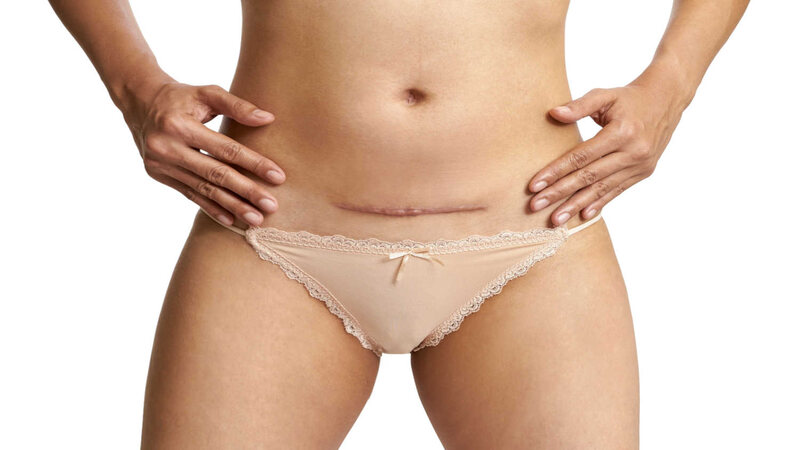
Motherhood is the most fulfilling phase, and as rightly said, birth is not about making babies, it’s about making mothers. The moment she takes her baby in her arms, a mother forgets all her pain and discomfort. There are a lot of changes that take place in a woman’s life after pregnancy. Pregnancy weight gain is one such thing, especially the post-pregnancy pouch, which can hamper a woman’s self-esteem. But then your body needs time to heal and recover after delivery, especially if you have had a C-section. So how long do you have to wait to reduce your tummy after C-section?
You might have heard that if you worked out systematically, it is possible to get back to your pre-pregnancy shape. Pushing yourself to lose those extra pounds and to get your body back into pre-baby shape after a C-section can lead to unnecessary complications and prolong the healing process. So calm down. Here are some effective ways that will help you to reduce the tummy after a c-section (1).
How To Reduce Tummy After C Section?
Birthing is a beautiful process, but having a baby through a C-section can be worrisome and can cause discomfort to the new mother. Some common discomforts after a C-section include painful stitches, discomfort when walking, difficulty when using the washroom, etc
Postoperative recovery is vital. Exerting yourself after a C-section can delay the healing process. It is important to wait for the stitches to dissolve and the incision to heal before you start to indulge in any weight loss activity after a C-section.
Reducing the tummy after a C-section is not easy, and it becomes all the more difficult if you have gone through a C-section delivery. This is because, after a C-section, you cannot do standard abdominal exercises for some time. But then here are some alternative ways to have a visibly flatter tummy after a C-section.
[Read: Changes That Happen After Delivery]
6 Tips To Reduce Tummy After C Section
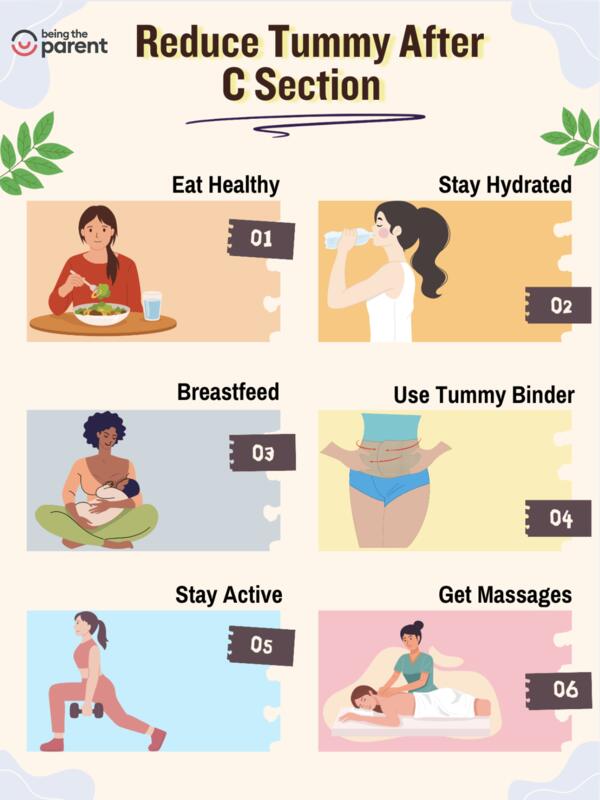
Here are some ways in which you can reduce your tummy after c section naturally before starting any strenuous exercises
1. Eat Healthy
Make sure your diet is rich in carbs and low in fat. Breastfeeding mothers need a healthy diet as they require more energy to take care of themselves and their baby. A high-carb diet, with sufficient vitamins and minerals, is crucial for repair and recovery (1).
At the same time, avoid food with saturated fats and sweets. Stay away from butter, and fried foods, and also from sugary beverages and aerated drinks (2). Include more fruits, vegetables, and protein in your diet
2. Drink Plenty Of Water
Drinking water will not only help to maintain fluid balance but also help to burn off any excess fat from your body post-cesarean delivery. So go ahead and up your water game
3. Breastfeeding
Breastfeeding is one of the easiest ways to lose those extra kilos you piled up during pregnancy. Research studies suggest that breastfeeding can initiate weight loss in new mothers (3). Breastfeeding mothers can enjoy additional benefits too such as quicker recovery, better heart health and reduced risk of cancers.
You will have to breastfeed your baby exclusively for the first six months after a C-section. This will help to reduce belly fat.
4. Tummy Binder
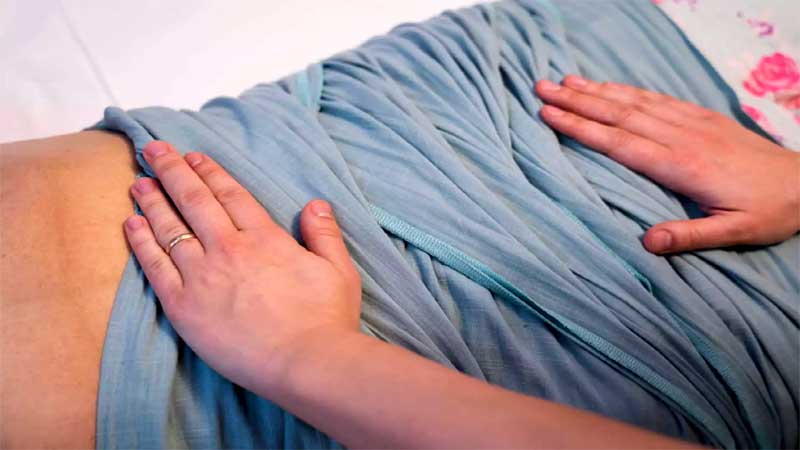
An age-old process of tucking in the tummy is the tummy binder. In this, the post-C-section tummy is tied up with a muslin cloth like a bandage.
This increases the mobility among new mothers, allows them to do light exercises, and helps reduce pain and physical stress, thus allowing for the initiation of weight loss. But you can do this only 2 months after c-section to reduce tummy when your incision has properly healed.
5. Move Your Body
A C-section causes a lot of stress on the pelvic floor and abdominal muscles (4). This is because a C-section can cut through some of the stomach muscles resulting in a pouch-like stomach after delivery.
Post-C-section, women can resume light physical activities at least 4 to 6 weeks after delivery. This can help in weight reduction, overall health and psychological well-being (5).
It is recommended that you take at least 6-8 weeks after a C-section before starting to move aggressively or exercise (6).
Walking is a low-impact exercise that burns calories and helps to increase your metabolism. One of the easiest methods to start getting in shape after delivery is by going for a walk (7).
Walking will not push you to the extremes. Going for a brisk walk at least three times a week can do wonders in regaining the belly shape.
6. Massage
Post-pregnancy massages have great advantages (8). And there is no harm in getting a massage after a C-section as well. The only thing is that you have to wait for two weeks before you get a massage. This is a period during which any complication associated with surgery surfaces. Once that period is over, you can indulge in massages without any problem.
Still, you have to keep a couple of points in mind. During the initial days, avoid the abdominal area and concentrate more on the back, legs, and hands.
Normally 4 Weeks after the surgery, your body will heal, and scar tissues will start to form. You will now be able to lie on your tummy without any pain. From this stage onwards, you can concentrate the massage on your abdominal area.
Massage in the abdominal area helps to break up the belly fat. The massage also helps to lose the fluids in lymph nodes, thereby reducing your waist (9).
[Read: 10 Tips to Hire Maalishwali (Masseuse) After Delivery]
4 Safe Yoga Poses To Reduce Belly After C Section
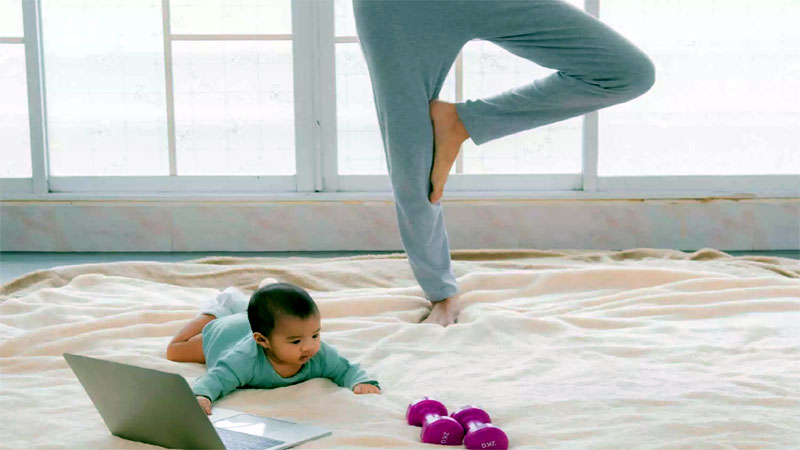
Practicing yoga post delivery is a good option for reducing tummy fat. It will help to tone and strengthen the stomach muscles (10).
Practice yoga only 6-8 weeks after delivery. Do consult with your doctor to get a green signal from them before you engage in yoga. You can start with simple breathing exercises for the first 2-3 weeks. It is an effective way to reduce tummy after a c-section (11).
However, if you have not practiced yoga until now, hire a certified yoga practitioner and start with relatively safe asanas during the initial period.
Yoga also helps new mothers deal with all the stress and strain of having a newborn around and an erratic schedule (12).
Some of the yoga poses that you can indulge in after a C-section that will help to reduce belly fat include:
- Pranayama: Helps to tighten your muscles and tuck in your tummy
- Vriksasana or Tree Pose: This asana will strengthen your pelvic area and improve stability
- Bhujangasana or snake pose: This will help to lose the fat around your belly
- Suryanamaskar or Sun Salutations: Once your body gets used to doing these normal asanas without any stress, you can move on to Suryanamaskar or Sun Salutations. It is an easy way to get back in proper shape by stretching the abdominal muscles and helps lose that extra flab around the belly naturally
5 Exercises That Help To Reduce Belly Fat After C Section
You can design your exercise routine once the doctor permits you to exercise. The exercise will help to reduce your tummy by strengthening the abdominal muscle and burning the accumulated fat around the hips and core.
Start with mild exercises. If possible, hire a physical trainer to design an exercise routine suitable for your body and health.
Also, wearing a compression garment will put gentle pressure on the C-section wound so that pain due to movement can be avoided.
Some of the exercises that you can indulge in once you recover from a C-section you can reduce your tummy after a C-section are
- Forward bends that help to strengthen the lower back
- Bridges to strengthen the hip
- Kegels to strengthen the pelvic floor (13).
- Pelvic tilts
- Planks.
Planks exercise strengthens the abdominal muscle just as crunches do, but are not as intense as crunches and sit-ups. It put zero pressure on the C-section wound.
[Read: 12 Fun Exercises To Do With Your Baby – Being The Parent]
Abdominal Belt To Reduce Tummy After C Section
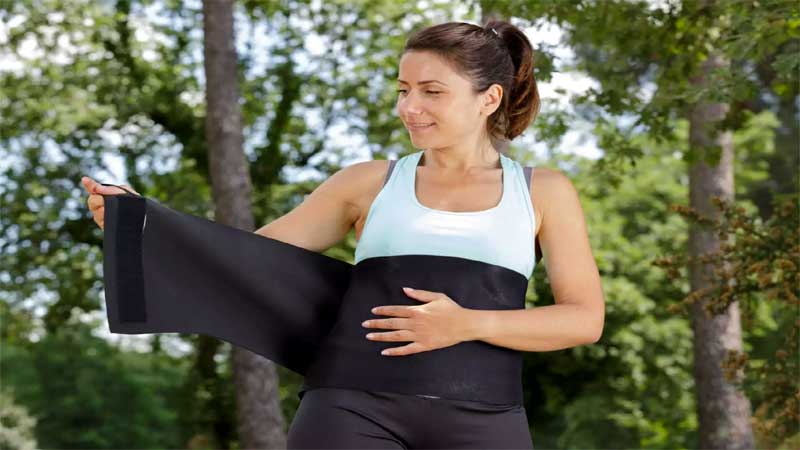
Wearing an abdominal belt to reduce tummy after c-section will help to support your body and also helps to regain the firmness of the tummy after delivery (14). At the same time, using a maternity belt can have adverse effects on the C-section wound, especially if the woman is overweight.
Therefore, consult the doctor before trying any such items to reduce belly after a C-section. Don’t forget that a C-section is a major surgery that comprises an incision that is made in the deeper layers of the abdomen. Hence, the healing takes time, and any wrongly applied abdominal pressure can, in turn, interfere with the healing process.
Here are some of the benefits of wearing an abdominal belt to reduce tummy after a c-section:
- The abdominal belt will hold the abdomen firmly in place, thereby healing the stitches faster
- The movement of the body after a C-section will usually be painful, especially during sitting down and getting up.
- An abdominal belt by holding the loose flab on the tummy together will help to ease such movements.
- The muscles on the back weaken during pregnancy. Wearing an abdominal belt will support the back muscle and help to recover its strength.
Belly After C Section – Issues With Belly Post C Section
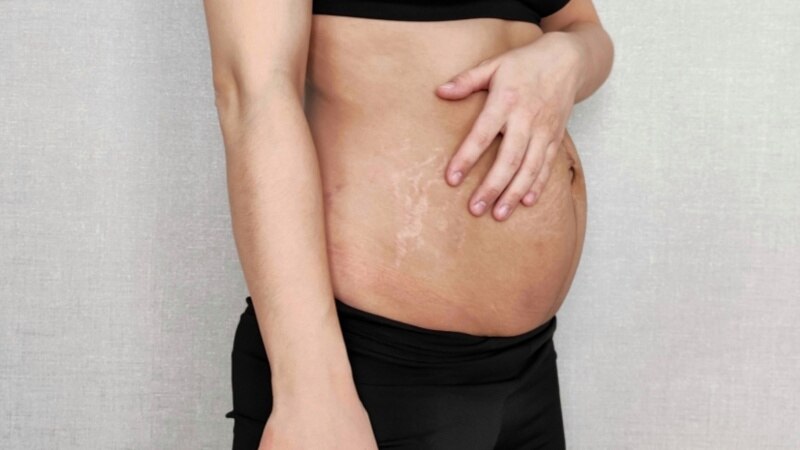
After a C-section delivery, you may have recovery expectations and some issues with the belly. Typically, recovery post-C-section involves several weeks and even months.
During the recovery time, you might face postpartum issues such as mood swings, breast engorgement, and lochia or postpartum bleeding. Many women often notice bruising and swelling around the incision site. However, this swelling usually begins to decrease after some time.
Some women often experience numbness near the C-section or belly incision due to nerve damage. This is common after a C-section to expect a belly bulge above your incision line.
The belly bulge can occur due to the tissue healing process and the presence of excessive skin and fat around the incision line.
[Read: 10 Effective Treatments For Relieving Engorged Breasts]
Belly After C Section – Expectation of Recovery
After C-section, women are always concerned about recovery, thinking about how long it takes to recover completely or get back into shape.
In the first few weeks, you can manage pain with prescribed medicines. However, you must avoid lifting heavy weights and gradually shift to mobility.
It is essential to keep the incision site dry and clean to prevent chances of infection during the initial days. Be sure to look for signs of infection, such as pus, redness, and swelling (15).
Intermediate Recover (6-8 Weeks)
Follow your appointments for post-operative checkups for proper healing. If your recovery is fine, start performing gentle exercises as described by the doctor to strengthen your abdominal muscles. Avoid performing core-intense workouts unless you get clearance from a doctor (16).
Long-Term Recovery (3-6 Months and Beyond)
Once your body begins to heal, you can use silicone gel-based cream or sheet to reduce scar appearance (17).
This is the right time to increase your workout intensity and start abdominal exercises. Take a proper diet and start following healthy, nutrient-rich meals to reduce weight.
[Read: 10 Simple Tips For A Speedy C-Section Recovery]
C-Section Pouch – Causes, Management, Tips, And Long-Term Solutions
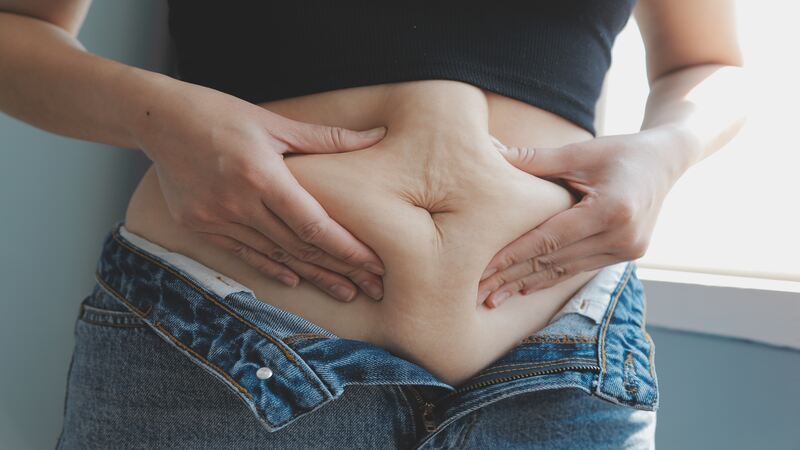
After C-Section delivery, you may experience an apron belly, also known as a belly pouch (18). It generally occurs due to excessive fat and skin in the abdominal area formed during pregnancy.
A C-section pouch can also occur when an incision over the abdominal region does not heal completely.
To reduce the C-section pouch, one can try these tricks and tips (19).
- Start eating a well-balanced meal and opt for a healthy lifestyle.
- Start regular workout
- Sleep at least 8 hours daily.
- Avoid vigorous activities that cause strain on your abdominal muscles.
- Stay hydrated and drink enough water when breastfeeding
- Maintain good posture to support the abdominal wall and core muscles.
- Wear a belly band to compress the belly pouch.
Motherhood is meant to be celebrated and enjoyed, and you can only do this when you are in the present moment, with a calm state of mind and a healthy body. So go ahead and try these tips to get that tummy fat out of your way.
When Can I Start Bending After C-Section – When It Is Safe to Start Bending and Other Movements Post C-Section?
After a C-section delivery, the most difficult task for a woman is bending down. Remember, 4-6 weeks is recovery time, and you should avoid bending down because it may cause strain over the abdominal region. Moreover, bending during the first few weeks may cause excessive pressure on the incision, and there is a risk of incision rupture and bleeding.
Experts advise waiting for a few weeks before you begin to practice bending (20).
- After 4-6 weeks of recovery or your 40 day confinement period, slowly try to bend using any support.
- Take support from your partner or family member during the initial weeks.
- After a few weeks, begin to bend forward with support and stand.
- Use your forearms to lift yourself while bending and standing.
- Do light bending workouts like bending forward and standing upright.
- Bend down on your knees slowly.
Abdominal Binder After C Section – Benefits, How to Use Them, and Their Role in Postpartum Recovery
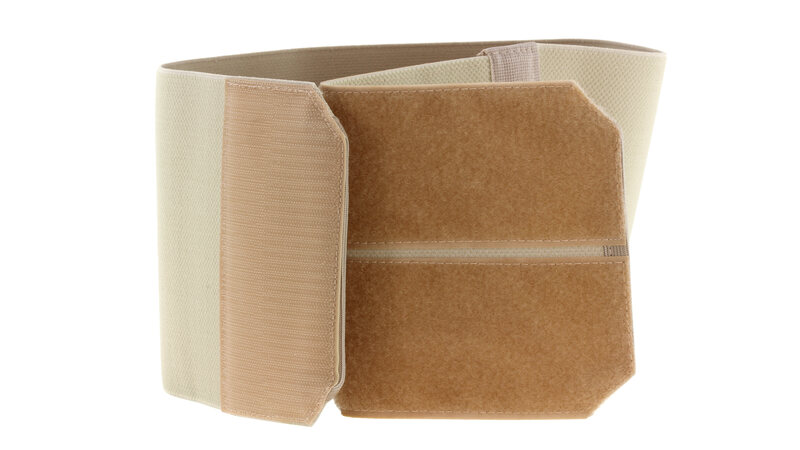
Belly pouches begin to appear after C-section due to excessive skin and fat. There are some postpartum abdominal binders, also known as belly bands, available that help to wrap the belly and push it inwards (21).
These abdominal binders provide various benefits to women after the birth of a baby through C-section, such as:
- Pain management
- Reducing swelling at the surgery site or incision site
- Acting as support bands that help you move properly
- Helping to improve posture
- Supporting pelvic floor and abdominal muscles
During pregnancy, two large muscles run downward or at one side of the stomach, which results in the splitting of the stomach apart as your uterus begins to expand.
Wearing an abdominal binder for the postpartum belly helps to compress the belly and hold muscles firmly in place.
FAQ’s
1. How Long After C-Section Will My Belly Go Down?
After a C-section, the time it takes for your belly to go down can vary from person to person. Generally, it takes several weeks to a few months for the swelling and bloating to subside. The uterus needs time to shrink back to its pre-pregnancy size, and the abdominal muscles and skin need time to recover. Additionally, factors such as individual healing, exercise, diet, and overall health can affect how quickly your belly returns to its pre-pregnancy appearance.
2. Does Maternity Belt Reduce Tummy?
A maternity belt, also known as a belly support belt, is primarily designed to provide support and alleviate discomfort during pregnancy by helping to distribute the weight of the baby bump and provide stability to the lower back and abdomen. While it can help with posture and relieve strain on the abdominal muscles, it is not specifically designed to reduce tummy size or aid in weight loss.
3. Is It Necessary To Tie Stomach After Delivery?
There is no medical necessity to tie or bind the stomach after delivery. Traditionally, some cultures have used postpartum belly-binding practices with the belief that they provide support, promote healing, and help the uterus shrink back to its pre-pregnancy size. However, there is limited scientific evidence to support these claims.
4. Can Breastfeeding Aid in Tummy Reduction Post C-Section?
Yes, breastfeeding is helpful in tummy reduction post-C-section delivery. Regularly breastfeeding the baby can help burn around 500 calories a day. Several studies also show that breastfeeding women may shed weight within 3-6 months after delivery.
5. Is Using a Postpartum Belly Wrap Safe After Undergoing a C-section?
A. Postpartum belly wrap also known as abdominal wrap is safe to use after undergoing a C-section. However, you may need to wait until the incisions are completely healed. Once your incision has completely dried out, you can use postpartum wrap to reduce the tummy and strengthen your abdominal muscles. But do be sure to avoid wearing postpartum belly wrap too early because it can cause infection and suture bursting. Avoid it for at least 3-4 weeks before using a wrap.
6. How Does Diet Influence Tummy Reduction Following C-section?
A healthy and nutrition-rich diet can help to reduce the tummy after C-section. Eating a balanced meal that includes high protein can enrich you with essential vitamins, minerals and carbohydrates that help to meet your body goal faster.
7. Which Exercises Should be Avoided After Having a C-section?
Avoid intense core workouts, running, sprinting, heavy weight lifting and strenuous exercises like Zumba during your C-section recovery period. Talk to your doctor about the right time to start exercising and include light walking or light jogging in the initial period.
Read Also: Traditional Indian Postpartum Care
References
- Nicole E. Marshall, MD, Barbara Abrams, DrPH, RD, Linda A. Barbour, MD, MSPH, Hora Soltani, PhD, MMedSci, RM, PGDip, PGCert, Jacqueline Wallace, PhD, DSc, Kent L. Thornburg, PhD, American Journal of Obstretics & Gynecology, The importance of nutrition in pregnancy and lactation: lifelong consequences, Dec 27, 2021- https://www.ajog.org/article/S0002-9378(21)02728-9/fulltext
- Nansel TR, Cummings JR, Burger K, Siega-Riz AM, Lipsky LM. Greater Ultra-Processed Food Intake during Pregnancy and Postpartum Is Associated with Multiple Aspects of Lower Diet Quality. Nutrients. 2022 Sep 22;14(19):3933.- https://www.ncbi.nlm.nih.gov/pmc/articles/PMC9572643/
- Neville CE, McKinley MC, Holmes VA, Spence D, Woodside JV. The relationship between breastfeeding and postpartum weight change–a systematic review and critical evaluation. Int J Obes (Lond). 2014 Apr;38(4):577-90. – https://pubmed.ncbi.nlm.nih.gov/23892523/
- Duran S, Vural G. Problems Experienced by the Mothers in Post-Cesarean Period: A Narrative Review. Iran J Public Health. 2023 Oct;52(10):2036-2041. – https://www.ncbi.nlm.nih.gov/pmc/articles/PMC10612559/
- Gilinsky, Alyssa, STORRE: Stirling Online Research Repository, University of Stirling, Promoting physical activity among postnatal women: the More Active Mums in Stirling (MAMMiS) study, 2014 – https://dspace.stir.ac.uk/handle/1893/21226
- Duran S, Vural G. Problems Experienced by the Mothers in Post-Cesarean Period: A Narrative Review. Iran J Public Health. 2023 Oct;52(10):2036-2041. – https://www.ncbi.nlm.nih.gov/pmc/articles/PMC10612559/
- ELa New JM, Borer KT. Effects of Walking Speed on Total and Regional Body Fat in Healthy Postmenopausal Women. Nutrients. 2022 Jan 31;14(3):627. – La New JM, Borer KT. Effects of Walking Speed on Total and Regional Body Fat in Healthy Postmenopausal Women. Nutrients. 2022 Jan 31;14(3):627. – https://www.ncbi.nlm.nih.gov/pmc/articles/PMC8840715/
- American Pregnancy Association- Postpartum Massage- https://americanpregnancy.org/healthy-pregnancy/first-year-of-life/postpartum-massage/]
- Kim Dong Hee, Ahn Hong Seok, The Effect of Abdominal Massage Six Months Postpartum on Body Composition, J Korean Soc Cosmetol, 2011; 17(6), 1048-1058.
– [https://www.e-jkc.org/journal/view.php?number=1132] - Ranjan P, Baboo AGK, Anwar W, Kumari A, Pradhan B, Maharana S, Venkataraman S. Physical Activity, Yoga, and Exercise Prescription for Postpartum and Midlife Weight Management: A Practical Review for Clinicians. J Obstet Gynaecol India. 2022 Apr;72(2):104-113. – https://www.ncbi.nlm.nih.gov/pmc/articles/PMC9008094/
- Rean Foundation – The Positive Benefits of Postnatal Yoga- Postnatal Yoga- A Detailed Analysis Of Its Benefits – https://www.reanfoundation.org/benefits-of-postnatal-yoga/
- Munns L, Spark N, Crossland A, Preston C. The effects of yoga-based interventions on postnatal mental health and well-being: A systematic review. Heliyon. 2024 Jan 29;10(3):e25455. – https://www.ncbi.nlm.nih.gov/pmc/articles/PMC10845905/
- Zhu H, Zhang D, Gao L, Liu H, Di Y, Xie B, Jiao W, Sun X. Effect of Pelvic Floor Workout on Pelvic Floor Muscle Function Recovery of Postpartum Women: Protocol for a Randomized Controlled Trial. Int J Environ Res Public Health. 2022 Sep 4;19(17):11073. – https://www.ncbi.nlm.nih.gov/pmc/articles/PMC9517758/
- The effectiveness of the abdominal binder in relieving pain after cesarean delivery: A systematic review and meta‐analysis of randomized controlled trials – Abd‐ElGawad – 2021 – International Journal of Gynecology & Obstetrics – Wiley Online Library – https://obgyn.onlinelibrary.wiley.com/doi/10.1002/ijgo.13607
- Mount Sinai, New York, Going home after a C-section Information – https://www.mountsinai.org/health-library/discharge-instructions/going-home-after-a-c-section
- Canada.ca, Government of Canada., Your Guide to Postpartum Health and Caring for Your Baby – [https://www.canada.ca/en/public-health/services/child-infant-health/postpartum-health-guide.html
- Puri N, Talwar A. The efficacy of silicone gel for the treatment of hypertrophic scars and keloids. J Cutan Aesthet Surg. 2009 Jul;2(2):104-6. – https://www.ncbi.nlm.nih.gov/pmc/articles/PMC2918339/
- Osman, Juliana & Tajuddin, Rosita & Omar, Noorkardiffa & Shariff, Shaliza. (2023). Examining Undergarment Preferences During Confinement Period towards Designing Caesarean Undergarment Design for Plus-Size Patients. Environment-Behaviour Proceedings Journal. 8. 121-128. 10.21834/e-bpj.v8iSI16.5234. – https://www.researchgate.net/figure/Apron-belly-after-a-caesarean-section-procedure-on-a-plus-size-patient-ii_fig2_376392871
- UNM Health Blog, Albuquerque, New Recovering from a C-section: What’s Normal and When to Call the Doctor – https://unmhealth.org/stories/2022/10/c-section-recovery-whats-normal-when-to-call-doctor.html
- Elizabeth Gibbs, Shweta Pradhan Hertforshire Community, NHS Trust, Jan2014. https://www.enherts-tr.nhs.uk/wp-content/uploads/2019/10/M-After-Your-C-Section-c-section_infoleaflet2014-1.pdf
- Karaca I, Ozturk M, Alay I, et al. Influence of Abdominal Binder Usage after Cesarean Delivery on Postoperative Mobilization, Pain, and Distress: A Randomized Controlled Trial. Eurasian J Med 2019; 51(3): 214-8. – https://www.researchgate.net
Read Also: Postpartum Belly

